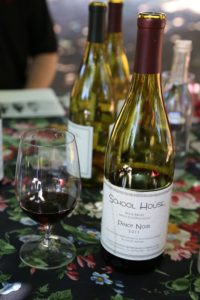 School House Vineyard is a very small producer of entirely estate wines nestled in the hills of the Spring Mountain District a few hundred yards in on Langtry Road at about 1500 feet. A visit here is for the serious wine enthusiast – their vineyard is truly off the beaten path, there is no tasting room or ‘Napa fancy’; all tastings are conducted next to the vineyard. Their vineyard is located in the Spring Mountain District. It is quiet and relaxed here; this is the Napa Valley’s unassuming mountain appellation. Rather than being winemakers, proprietors, John M. Gantner and Nancy Walker focus their efforts on vineyard management and sales of their wines.
School House Vineyard is a very small producer of entirely estate wines nestled in the hills of the Spring Mountain District a few hundred yards in on Langtry Road at about 1500 feet. A visit here is for the serious wine enthusiast – their vineyard is truly off the beaten path, there is no tasting room or ‘Napa fancy’; all tastings are conducted next to the vineyard. Their vineyard is located in the Spring Mountain District. It is quiet and relaxed here; this is the Napa Valley’s unassuming mountain appellation. Rather than being winemakers, proprietors, John M. Gantner and Nancy Walker focus their efforts on vineyard management and sales of their wines.
John has a rich and lengthy family history in northern California; he is 8th generation San Franciscan whose relatives’ generations ago were the Vallejo family – his great, great grandfather was Salvador Vallejo, the brother of General Mariano Vallejo. For those interested in additional history of Spring Mountain and John’s time growing up here in the 1940s – consider ordering Spring Mountain Story from the School House website, a book John wrote that was published in 2019. At only 40 pages, this book is a quick read but offers a rare glimpse into a very specific piece of Napa Valley’s history. Deer, rattlesnakes, no electricity and few neighbors; this book is John’s story of growing up on Spring Mountain between 1940 and 1951.
Some of John’s other relatives have connections to the Napa Valley; his great grandfather worked in California gold mines during the goldrush and later owned the Swiss Hotel in San Francisco. Records show that he traveled to Napa in the 1860s to purchase barrels of wine to serve guests in his hotel. And his grandmother, Dorothy Erskine was one of the early proponents of a greenbelt or space that would remain zoned as agricultural. Her efforts along with Jack Davies of Schramsberg, Volker Eisele of Volker Eisele Vineyard and others created the nation’s first such preserve in 1968, the Napa Valley Agricultural Preserve. And to honor her efforts in San Francisco (she founded People for Open Space, now the Greenbelt Alliance) – a tiny park full of eucalyptus trees and great views overlooking southern San Francisco. Her namesake, the Dorothy W. Erskine Park is located just south of Twin Peaks in San Francisco. Visitors can access the park from the surrounding residential neighborhood or drive all the way up to the edge of the park and make a very short hike.
Ganter-Mattern Mementos
Dorothy W. Erskine Park, San Francisco
John’s father John Oscar Gantner (died 2002) senior purchased 160 acres, the current site of School House Vineyard in 1940 for $8,700 (the year John was born) from Dick Sheehan (the property had been in she Sheehan family since the 1860s). John Oscar looked for property in the Mayacamas mountains at the urging from his college friend at Stanford University, John Daniel (owner of Inglenook Vineyards at that time). John’s grandfather co-founded Gantner-Mattern, a clothing company around 1900. They produced a variety of products over the years including underwear, sweaters and swimsuits for both men and women. Their wikies for men were particular popular. John’s father ran the company until 1954 before selling it.
John Oscar initially sold grapes – the white variety, Golden Chasselas went to one of his neighbors slightly lower on Spring Mountain, Karl Beringer (that property was much later known as Eeden Vineyards and today is the home of Titanium Vineyards) and their reds went to Allied Grape Growers, a cooperative. Much later fruit from an acre of mixed reds was sold to Paul Draper at Ridge Vineyards every year for more than 20 years.
Nancy’s formative years were spent in Oklahoma City, Newport Beach and then Berkeley. She has a varied career – first with United Airlines in 1960 – continuing her work in the travel business for 15 years and later becoming elected to the San Francisco Board of Supervisors in 1979.
John and Nancy subscribe to the saying that 90% of the wine making is done in the vineyard; John has worked these vineyards all his life. Other than watering young vines to get them established, this vineyard is entirely dry farmed. The Gantner’s worked with noted winemaker Bob Foley for many years; today School House Vineyard produces approximately 3,000 cases a year of several different wines. Their vineyard is named after a small one-room schoolhouse built in 1881; John’s family actually lived inside this old schoolhouse for several years after they purchased the property. And much later, Tim Mondavi (Robert Mondavi’s son) also lived here. Unfortunately, it burned down in 1986. Visitors to their property will pass by the original site where this was located.
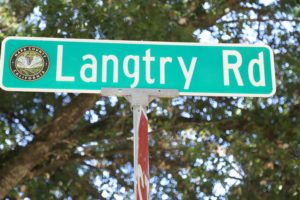
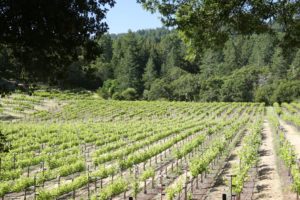
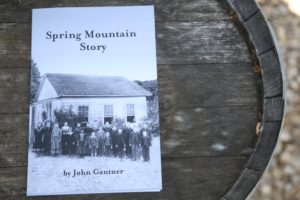 The original vines on the property were planted in the 1870s; the vineyard has produced continuously since then. At the time of John Sr’s purchase, there were 30 acres under vine and the vineyard was being managed by horses. After horses were replaced by tractors, some of the steepest vineyards blocks were no longer maintained due to the danger of turning a tractor around at the end of these very steep rows. Today of the 55 acres they own, they manage about 17 acres of vines.
The original vines on the property were planted in the 1870s; the vineyard has produced continuously since then. At the time of John Sr’s purchase, there were 30 acres under vine and the vineyard was being managed by horses. After horses were replaced by tractors, some of the steepest vineyards blocks were no longer maintained due to the danger of turning a tractor around at the end of these very steep rows. Today of the 55 acres they own, they manage about 17 acres of vines.
Their three vintages of 1957, 1958 and 1959 were made at Stony Hill Winery. Stony Hill is one of Napa Valley’s more historical wineries and is also located on Spring Mountain. The School House winemaking operations have been highly nomadic over the years including being including being produced at California’s oldest winery, Buena Vista in neighboring Sonoma County and at Chateau Montelena for some time. They have also employed a wide diversity of wine makers over the years while always keeping a careful eye out for balanced wines with restraint on ripeness and extraction. Some of their winemakers have included André Tchelistcheff, Mike Chellini, Ric Forman (who seems like he has been involved with nearly every Napa Valley winery producing wine in the 1970s and 1980s) and Bo Barrett among others.
Until 2022 the wines were made at Pride Mountain Vineyards, also in the Spring Mountain appellation and conveniently located less than 10 minutes away from School House. However, starting in 2023 the wines are now made at Tamber Bey Vineyards in Calistoga.
Remarkably they have produced wines every year since 1957, making this one of the longest continuously operating winery producers in all of Napa Valley. By our count they are one of only 8 wineries that have produced vintages in Napa Valley under the same brand every year since at least the 1950s – who are still producing today, the others being: Beringer, Nichelini, Beaulieu, Louis Martini, Charles Krug, Sutter Home and Stony Hill (listed in order of earliest age of continuous production).
Some of the oldest 100+ year vines (Zinfandel) are still growing on site, intermingled in with much newer plantings. Parts of their vineyard were replanted in 2024 including removing the oldest diseased and very low yielding Pinot Noir vines and replanting blocks to both Pinot Noir and Grenache.
Select Wines
Whites
John’s father was friends with Fred McCrea, founder of Stony Hill Winery (also on Spring Mountain); the School House Chardonnay came from Wente “small berry” cuttings that Fred gave him in 1968. Along with the Haynes Vineyard in Coombsville, these are both the oldest Chardonnay plantings in Napa Valley.
The 2021 School House Chardonnay is medium gold in color; the pleasing bouquet offers scents of lightly buttered popcorn, vanilla, jasmine, freshly cored Golden delicious apple, pineapple and light stone fruit influences including apricot and peach. And a light but lingering note of hazelnut which will probably become more pronounced as this wine ages. One can tell this is Chardonnay while at the same time one can clearly tell this is not an oaky or butter expression of the variety. Minerally with a light flinty character, this superbly balanced bottling delivers flavors of red delicious apple, comise pear, apricot, yellow nectarine, mango, papaya, pineapple guava and lingers with a light note of dried dill seed. The bright and balanced acidity begs another sip. It is fully ripe at 13.2% alcohol. This wine was aged for 18 months in used French oak barrels. Highly worth seeking out, especially for those who have had unpleasant experiences drinking mass produced Chardonnay.
The 2018 School House Chardonnay is medium to deep gold in color; one often associates 100% malolactic fermentation with buttery characteristics both on the bouquet and on the palate, but this wine does not have that. The bouquet shows aromatic of lemon/lime, citrus blossom and not overly ripe pineapple. As the wine evolves in the glass offers subtle aromatics of papaya and vanilla. From the aromatics alone, one would be hard pressed to guess this is a hillside grown Napa Valley Chardonnay. The mouth feel is supple and slightly creamy with flavors of red apple, hazelnut and a thread of minerality showing from start to finish. Offers a lingering and refreshing brightness of acidity. This wine was aged in used French oak barrels for 10 months sitting on the gross lees which were stirred every week.
The 2012 School House Vineyard Chardonnay shows a pretty golden hue in the glass revealing aromas of honeysuckle, crème Brule and brown sugar notes. On the palate it is all about the variety and fruit characteristics rather than oak or manipulation in the winery. It is a balanced Chardonnay which is slightly creamy (not oaky or buttery) with lingering mineralities on the finish.
Pinot Noir
Their small vineyard contains budwood from several very respectable Napa sources. The budwood from this wine came to be planted here as an indirect result of famed soils and winemaker André Tchelistcheff’s encouragement for local growers to remove other varieties and replace these with Cabernet Sauvignon. As a result, in 1952, John Daniel of Inglenook Winery decided to remove his one acre of Pinot Noir in Rutherford and gave some budwood to School House, supposedly originating from one of Domaine Romanée Conti vineyards in Burgundy. Pinot Noir planted in the 1960s or 1970s is nearly non-existent in Napa Valley; a couple of other producers we are aware of with Pinot Noir dating back to the late 1960s or early 1970s are the Haynes Vineyard in Coombsville and Stanley Ranch in Carneros.
The first wine released from the 1957 vintage was Pinot Noir; they still produce wine from this variety today. All grapes grown on site are dry farmed and are probably one of only a few wineries in California dry farming Pinot Noir. In addition, very few wineries on Spring Mountain actually grow Pinot Noir; Spring Mountain Vineyard used to grow Pinot Noir for many years. Ritchie Creek also has some Pinot Noir but is not producing wine from this themselves.
The 2017 School House Pinot Noir is pale ruby in the glass; shows an earthy and savory character across the bouquet including aromas of mushroom, old cedar box, dried herbs, dried rose petals and sandalwood along with fruit aromatics of red currant and cranberry. Shows an intensity of fruit across the palate with flavors of red cherry and raspberry. This wine is bright with decent acidity, balance and tannins that are fine-grained and softly integrated into the smooth yet rich finish. This wine was aged in new French oak for 11 months. We have tried select vintages of their Pinot Noir dating back to 2004; this wine is always crafted to be Burgundian in style.
Syrah
The 2020 School House Syrah is deep ruby in color; there are loads of red fruits on the bouquet including Santa Rosa Plum, raspberry and almost a citrus character including of blood orange. On the palate there are flavors of plum, tart cherry, blueberry, cranberry and raspberries. The mouth feel offers gravely and tumbled textured tannins with a persistent dusty character featuring. Juicy, fresh and crunchy acidity. Mouthwatering and tart, the finish begs another sip. While tasting this wine, we immediately thought of pairing it with a beef filled tomato based ravioli and a warm summer evening. We don’t usually mention 2020 red wines from Napa Valley as being age worthy, but this wine clearly has the characteristics to go quite a few years.
Mescolanza Zinfandel
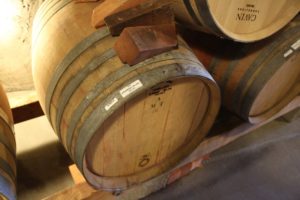
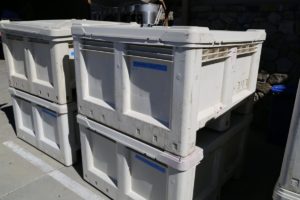
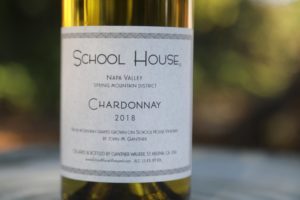 School House produces several Mescolanza wines (appropriately meaning “Medley” Spanish including a Zinfandel based wine, Syrah based wine and a Grenache based wine. These wines display the Vallejo family crest on the label. The Zinfandel is a delicious blend predominately of Zinfandel and Petite Syrah with a touch of Carignane, a Spanish red variety rarely grown in the Napa Valley. As Nancy says, “excessive consumption of this wine may cause Zinfomania”! And we have also heard this wine referred to as “the Forest Gump wine” indicating one never knows what the varietal blend will be each vintage.
School House produces several Mescolanza wines (appropriately meaning “Medley” Spanish including a Zinfandel based wine, Syrah based wine and a Grenache based wine. These wines display the Vallejo family crest on the label. The Zinfandel is a delicious blend predominately of Zinfandel and Petite Syrah with a touch of Carignane, a Spanish red variety rarely grown in the Napa Valley. As Nancy says, “excessive consumption of this wine may cause Zinfomania”! And we have also heard this wine referred to as “the Forest Gump wine” indicating one never knows what the varietal blend will be each vintage.
The 2020 School House Mescolanza Zinfandel Blend is also blended with Petite Syrah and Carignane. This wine is medium ruby in color; the bouquet offers aromas of red cherry, dried rose petals and hints of black pepper and chocolate. On the palate there are flavors of red plum, cherry and currant. Old school Zinfandel; by this we mean it is food friendly and not a cocktail Zinfandel. Did we just write that? Absolutely. And it is balanced, a word we often use to describe the School House bottlings. 13.2% alcohol. Lingers bright and red fruited with a lightly tart finish. Juicy. The well tumbled tannins linger with a light drying and dusty character on the finish which outpaces the fruit.
The 2017 School House Vineyard Mescolanza Zinfandel Blend is 76% Zinfandel, 17% Petite Sirah and 7% Carignane. The three varieties are picked together and co-fermented in open top t-bins. The wine is pale to medium ruby in color; upon opening the bouquet shows very earthy with aromas of mushroom, a recently used old baseball mitt on a hot day, freshly tilled earth and old cedar box. Give it time to open and it will do so, albeit reluctantly in its youth, but when it does the fruit shows more including notes of blackberry along with lavender. This bouquet has some character. Very balanced across the palate, showing flavors of raspberry and red cherry with lighter style earthy tannins anchoring a smooth finish. Very food friendly – think BBQ ribs; this is the antithesis style of more common fruit forward high alcohol, sweet, jammy wines made from this variety. Fruit from some of their approximately 100 year old vines is also in this wine.
The 2013 School House Zinfandel is medium ruby in color; the bouquet reveals initial aromas of sweaty baseball mitt, sweet tobacco spice, raspberry, red plum, and baked cherry. The fruit quickly opens in short time. The palate offers flavors of red licorice, sour cherry, raspberry, currant, and cranberry.
This wine sports a rounded texture with lightly grainy tannins. The finish is juicy and mouth watering. Remarkably fresh and surprisingly youthful; for reference we tasted this 11 years post vintage. This wine is showing in a sweet spot right now.
The 2011 School House Vineyard Mescolanza Zinfandel based blend shows some spicy white pepper notes, cassis and red fruit. It is balanced on the palate showing higher toned fruits – with a lingering tartness on the finish (red currant). The tannins are fine-grained, delicate and perfectly integrated into this wine’s structure.
Mescolanza Syrah
The Mescolanza Syrah is a newer School House project – made from a vineyard on site jointly planted with Pride Mountain. Old vines that originally were used by Beringer to make a sherry were pulled out and replaced with Syrah, Grenache and Mourvèdre.
The 2011 School House Vineyard Mescolanza Syrah based shows earthy notes on the bouquet with cedar and hints of white pepper. It is pleasing on the palate and very well balanced. We tried this same wine 10 years post vintage date; the bouquet had changed dramatically since our initial tasting which was soon after its release. The bouquet offers a noticeable intensity of ripe and very sweet aromatics including of blackberry jam, brown chocolate, and Graham cracker. The palate shows plenty of ripe fruit (blackberry and plum) and a tannin profile that is silky and very chalk-like.
The 2017 School House Vineyard Mescolanza Syrah is medium to deep ruby in color; this wine was co-fermented with 5% Grenache. Offers aromatics of darker fruits including plum and blackberry along with saddle leather, pepper and tobacco smoke. Offers flavors of cherry, black currant and raspberry. The tannins are gravelly and linger on the palate after the fruit has dropped off. This wine shows savory characteristics both on the bouquet and the palate. Very juicy finish. Very balanced. Should have plenty of aging potential. Nicely done. This vintage is the last blend from this particular part of the vineyard, moving forward and starting with the 2018 vintage, this wine will be labeled as a varietal Syrah.
Châteauwoof-da-Pup
In 2018 School House introduced the cleverly titled Châteauwoof-da-Pup a Grenache and Syrah blend. The equally cleverly designed label features their vineyard dog Roxy holding a bottle of wine in her paw. Initially they were growing more Syrah and when they decided to produce a Châteauneuf-du-Pape styled wine they realized to mimic some of the varietal blends coming from the Southern Rhone Valley of France they needed more Grenache – so they budded over some of their Syrah vines to Grenache.
The 2019 Châteauwoof-da-Pup Red Table Wine is a blend of 65% Grenache and 35% Syrah. This wine is pale ruby in color; offers earthy aromatics along with old cedar box, lavender, dried herbs and red cherry. This wine is very balanced across the palate offering bright acidity with flavors of currant, cranberry and raspberry and rhubarb. The tannins sport a light grip, are slightly gravely in their textural feel but well-integrated for such a youthful wine at the time of our tasting.
—
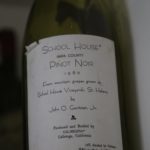 Tasting is an intimate experience sitting around the table often with Nancy or John at their home. They are setup to see only very small groups. And more recently, John’s daughter Florence spent several years helping out at School House Vineyard (born and raised in San Francisco, she spent much of her summers growing up at School House).
Tasting is an intimate experience sitting around the table often with Nancy or John at their home. They are setup to see only very small groups. And more recently, John’s daughter Florence spent several years helping out at School House Vineyard (born and raised in San Francisco, she spent much of her summers growing up at School House).
The Glass Fire of 2020 burned through much of the Spring Mountain District, destroying wineries and burning through vineyards. John and Nancy’s family home that was built in 1968 was completely destroyed as was much of the surrounding forest. Unfortunately the only remaining bottles from the 1950s were destroyed. John stayed during the fire and with help of firefighters the burning deck on their new home was cut off, in the process saving their new home from burning; it survived this fire. The original family home was rebuilt, completed in mid 2024 featuring much more resistant to fire materials.
Their wines are primarily sold direct to consumer. School House does maintain a library collection of their wines and some of these are often listed for sale on their website. For more information and or to join their mailing list, visit: www.schoolhousevineyard.com






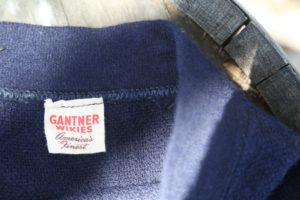
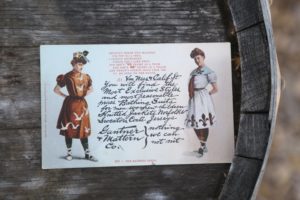
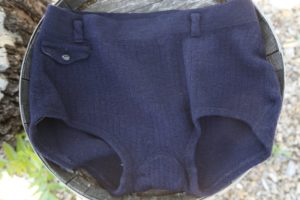

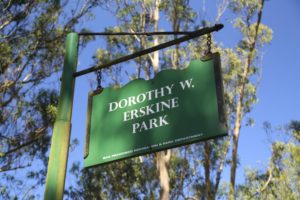
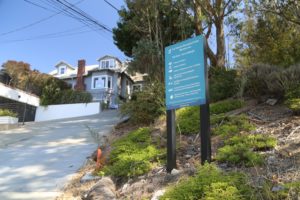
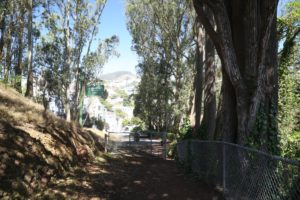

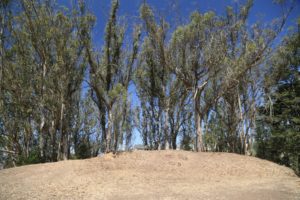
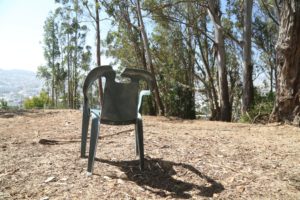

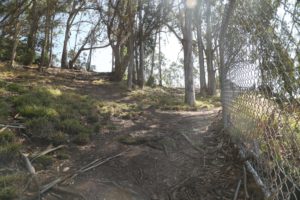
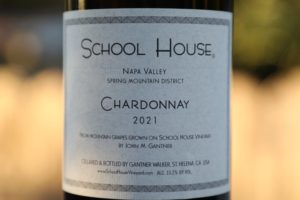
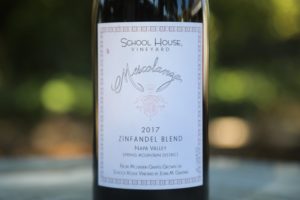
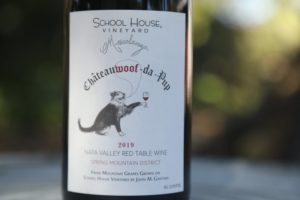
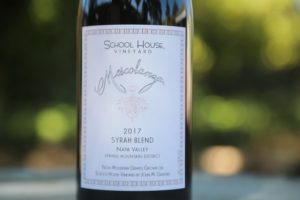
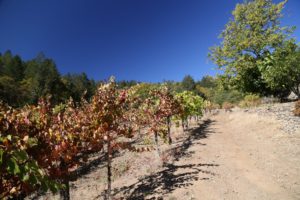

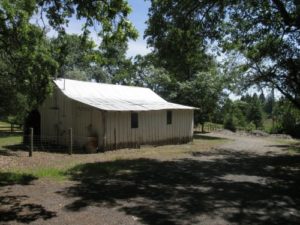
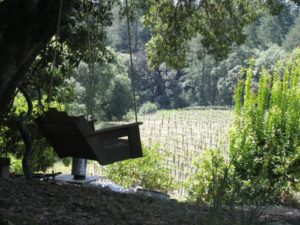
Leave a Reply